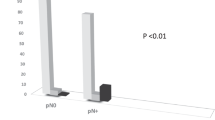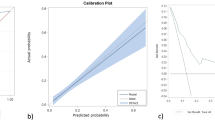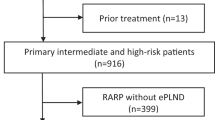Abstract
Background
The Briganti updated nomogram (BN) is the most popular predictive model aiming to predict the presence of lymph node invasion (LNI) in patients with prostate cancer (PCa), but it lacks information obtained by preoperative imaging.
The primary aim of the study was to evaluate the role of multiparametric prostate magnetic resonance imaging (mp-MRI) in the indication to perform pelvic lymph nodes dissection (PLND) or not in patients with risk of LNI according to BN below 5%.
Methods
Since March 2012 and September 2016, 310 patients who underwent a preoperative mp-MRI for staging purpose and subsequent robot-assisted extended PLND (RAEPLND) were retrospectively evaluated. Mp-MRIs were prospectively analyzed by two experienced radiologists. The imaging parameters analyzed were the presence of extracapsular extension (ECE), seminal vesicles invasion (SVI) and predominant Gleason pattern 4 (pG4). All patients underwent RAEPLND by two experienced surgeons with a standardized technique. A dedicated uropathologist performed all pathological analysis. Univariate analysis and multivariate logistic regression analysis were used in order to identify the predictors of LNI in patients with PCa.
Results
In the overall population, 57 (18.4%) patients had histologically proven pN1 disease. 48/250 patients (19.2%) with a risk of LNI ≥5% as calculated by the BN were staged pN1 at final histopathological analysis. 9/60 patients (15.0%) with a risk of LNI <5% as calculated by BN, who underwent RAEPLND anyway according to the findings at mp-MRI, were staged pN1 at final histopathological analysis. At multivariate logistic regression analysis, all the three mp-MRI parameters were significant independent predictors of LNI after RAEPLND.
Conclusions
The role of mp-MRI seemed to be crucial in patients with a risk of LNI <5% as calculated by the BN. The presence of ECE, SVI, or pG4 at mp-MRI was found to be an independent predictor of LNI by itself.
This is a preview of subscription content, access via your institution
Access options
Subscribe to this journal
Receive 4 print issues and online access
$259.00 per year
only $64.75 per issue
Buy this article
- Purchase on Springer Link
- Instant access to full article PDF
Prices may be subject to local taxes which are calculated during checkout


Similar content being viewed by others
References
Budiharto T, Joniau S, Lerut E, Van Den Bergh L, Mottaghy F, Deroose CM, et al. Prospective evaluation of 11C-choline positron emission tomography/computed tomography and diffusion-weighted magnetic resonance imaging for the nodal staging of prostate cancer with a high risk of lymph node metastases. Eur Urol. 2011;60:125–30.
Conti A, Santoni M, Burattini L, Scarpelli M, Mazzucchelli R, Galosi AB, et al. Update on histopathological evaluation of lymphadenectomy specimens from prostate cancer patients. World J Urol. 2017;35:517–26.
Orvieto MA, Coelho RF, Chauhan S, Palmer KJ, Rocco B, Patel VR. Incidence of lymphoceles after robot-assisted pelvic lymph node dissection. BJU Int. 2011;108:1185–90.
Eifler JB, Levinson AW, Hyndman ME, Trock BJ, Pavlovich CP. Pelvic lymph node dissection is associated with symptomatic venous thromboembolism risk during laparoscopic radical prostatectomy. J Urol. 2011;185:1661–5.
Keegan KA, Cookson MS. Complications of pelvic lymph node dissection for prostate cancer. Curr Urol Rep. 2011;12:203–8.
Pini G, Matin SF, Suardi N, Desai M, Gill I, Porter J, et al. Robot assisted lymphadenectomy in urology: pelvic, retroperitoneal and inguinal. Minerva Urol Nefrol. 2017;69:38–55.
Albisinni S, Aoun F, LE Dinh D, Zanaty M, Hawaux E, Peltier A, et al. Comparing conventional laparoscopic to robotic-assisted extended pelvic lymph node dissection in men with intermediate and high-risk prostate cancer: a matched-pair analysis. Minerva Urol Nefrol. 2017;69:101–7.
Thompson I, Thrasher JB, Aus G, Burnett AL, Canby-Hagino ED, Cookson MS, et al. AUA Prostate Cancer Clinical Guideline Update Panel. Guideline for the management of clinically localized prostate cancer: 2007 update. J Urol. 2007;177:2106–31.
Heidenreich A, Bastian PJ, Bellmunt J, Bolla M, Joniau S, van der Kwast T, et al. EAU guidelines on prostate cancer. Part 1: screening, diagnosis, and local treatment with curative intent-update 2013. Eur Urol. 2014;65:124–37.
Briganti A, Larcher A, Abdollah F, Capitanio U, Gallina A, Suardi N, et al. Updated nomogram predicting lymph node invasion in patients with prostate cancer undergoing extended pelvic lymph node dissection: the essential importance of percentage of positive cores. Eur Urol. 2012;61:480–7.
Kiechle J, Pahwa S, Gulani V, Kanaan G, Sedelaar J, Ponsky L. Magnetic resonance imaging for prostate cancer: what the urologist needs to know. Minerva Urol Nefrol. 2015;67:201–10.
de Rooij M, Hamoen EH, Witjes JA, Barentsz JO, Rovers MM. Accuracy of magnetic resonance imaging for local staging of prostate cancer: a diagnostic meta-analysis. Eur Urol. 2016;70:233–45.
Soylu FN, Peng Y, Jiang Y, Wang S, Schmid-Tannwald C, Sethi I, et al. Seminal vesicle invasion in prostate cancer: evaluation by using multiparametric endorectal MR imaging. Radiology. 2013;267:797–806.
Bittencourt LK, Barentsz JO, de Miranda LC, Gasparetto EL, Prostate MRI: diffusion-weighted imaging at 1.5T correlates better with prostatectomy Gleason Grades than TRUS-guided biopsies in peripheral zone tumours. Eur Radiol. 2012;22:468–75.
Barentsz JO, Richenberg J, Clements R, Choyke P, Verma S, Villeirs G, et al. European Society of Urogenital Radiology. ESUR prostate MR guidelines 2012. Eur Radiol. 2012;22:746–57.
Sciarra A, Barentsz J, Bjartell A, Eastham J, Hricak H, Panebianco V, et al. Advances in magnetic resonance imaging: how they are changing the management of prostate cancer. Eur Urol. 2011;59:962–77.
Fütterer JJ, Briganti A, De Visschere P, Emberton M, Giannarini G, Kirkham A, et al. Can clinically significant prostate cancer be detected with multiparametric magnetic resonance imaging? A systematic review of the literature. Eur Urol. 2015;68:1045–53.
Porpiglia F, Russo F, Manfredi M, Mele F, Fiori C, Bollito E, et al. The roles of multiparametric magnetic resonance imaging, PCA3 and prostate health index-which is the best predictor of prostate cancer after a negative biopsy? J Urol. 2014;192:60–66.
Porpiglia F, De Luca S, Bertolo R, Passera R, Mele F, Manfredi M, et al. Robot-assisted extended pelvic lymph nodes dissection for prostate cancer: personal surgical technique and outcomes. Int Braz J Urol. 2015;41:1209–19.
Memorial Sloan Kettering Cancer Center. Prostate Cancer Nomograms Pre-Radical Prostatectomy. (2016) https://www.mskcc.org/nomograms/prostate/pre-op/coefficients. Accessed 20 December 2016.
Briganti A, Chun FK, Salonia A, Zanni G, Scattoni V, Valiquette L, et al. Validation of a nomogram predicting the probability of lymph node invasion among patients undergoing radical prostatectomy and an extended pelvic lymphadenectomy. Eur Urol. 2006;49:1019–26.
Hövels AM, Heesakkers RA, Adang EM, Jager GJ, Strum S, Hoogeveen YL, et al. The diagnostic accuracy of CT and MRI in the staging of pelvic lymph nodes in patients with prostate cancer: a meta-analysis. Clin Radiol. 2008;63:387–95.
Schiavina R, Scattoni V, Castellucci P, Picchio M, Corti B, Briganti A, et al. 11C-choline positron emission tomography/ computerized tomography for preoperative lymph-node staging in intermediate-risk and high-risk prostate cancer: comparison with clinical staging nomograms. Eur Urol. 2008;54:392–401.
Feng TS, Sharif-Afshar AR, Wu J, Li Q, Luthringer D, Saouaf R, et al. Multiparametric MRI improves accuracy of clinical nomograms for predicting extracapsular extension of prostate cancer. Urology. 2015;86:332–7.
Porpiglia F, Russo F, Manfredi M, Mele F, Fiori C, Regge D. Preoperative prostate biopsy and multiparametric magnetic resonance imaging: reliability in detecting prostate cancer. Int Braz J Urol. 2015;41:124–33.
Thoeny HC, Froehlich JM, Triantafyllou M, Huesler J, Bains LJ, Vermathen P, et al. Metastases in normal-sized pelvic lymph nodes: detection with diffusion-weighted MR imaging. Radiology. 2014;273:125–35.
Park SY, Shin SJ, Jung DC, Cho NH, Choi YD, Rha KH, et al. PI-RADS version 2: quantitative analysis aids reliable interpretation of diffusion-weighted imaging for prostate cancer. Eur Radiol. 2017;27:2776–83.
Acknowledgements
All the Authors thank Daniele Amparore, MD, for assistance with paper illustration.
Author information
Authors and Affiliations
Corresponding author
Ethics declarations
Conflict of interest
The authors declare that they have no conflict of interest.
Electronic supplementary material
Rights and permissions
About this article
Cite this article
Porpiglia, F., Manfredi, M., Mele, F. et al. Indication to pelvic lymph nodes dissection for prostate cancer: the role of multiparametric magnetic resonance imaging when the risk of lymph nodes invasion according to Briganti updated nomogram is <5%. Prostate Cancer Prostatic Dis 21, 85–91 (2018). https://doi.org/10.1038/s41391-017-0026-5
Received:
Revised:
Accepted:
Published:
Issue Date:
DOI: https://doi.org/10.1038/s41391-017-0026-5
This article is cited by
-
Development of a novel nomogram to identify the candidate to extended pelvic lymph node dissection in patients who underwent mpMRI and target biopsy only
Prostate Cancer and Prostatic Diseases (2023)
-
Impact of multiparametric MRI and MRI-targeted biopsy on pre-therapeutic risk assessment in prostate cancer patients candidate for radical prostatectomy
World Journal of Urology (2019)



